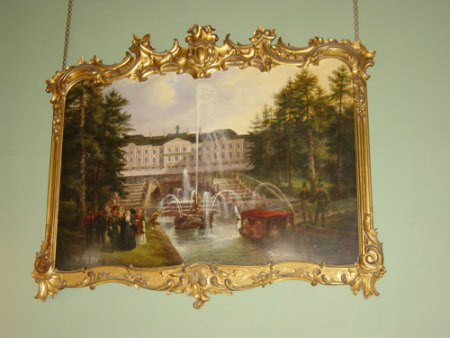Palace of Peterhof, Russia
Jennens & Bettridge
Category
Art / Oil paintings
Date
1850 - 1875
Materials
Oil on papier-mâché
Measurements
940 x 1397 mm (37 x 55 in)
Order this imageCollection
Wimpole, Cambridgeshire
NT 207771
Caption
Victorian taste makers had a thing or two to say about the art of Jennens & Bettridge, makers of this painting on papier-mâché. It depicts the Peterhof Palace, built for Peter the Great by the Italian architect Carlo Bartolomeo Rastrelli in 1747-55. The Palace, sometimes referred to as the ‘Russian Versailles’, was the official summer residence for Russian Emperors. The strolling couple depicted at left are probably Tsar Nicholas I and his wife Charlotte of Prussia. Famous for their finely made papier-mâché goods that could be worked like wood, Jennens & Bettridge employed a variety of professional artists to copy paintings onto their decorative wares, including trays, fans and painted panels for ship interiors. Many of these papier-mâché works were further decorated with mother-of-pearl inlay, Chinese- and Japanese-style lacquer and gilt ornamentation. This particular picture is displayed within an ornate, gilded frame, indicative of the riot of over-decoration that characterized the firm's aesthetic. One Jennens & Bettridge tray, now in the Victoria & Albert Museum, was included in Henry Cole’s exhibition of ‘False Principles of Decoration’ held at Marlborough House in 1852. This exhibition was Cole’s attempt to improve the taste of the British public by displaying objects he believed demonstrated good design next to objects that demonstrated bad design. The Jennens & Bettridge tray – with its derivative painting, gilt bolder and mother-of-pearl decoration – was considered a failure in the design stakes. The exhibition, dubbed the ‘Chamber of Horrors’ by the press, was hastily closed. Angry manufacturers complained that their goods were being slandered while the Victorian public largely ignored any attempt to change their aesthetic sensibilities, continuing to enjoy objects like this one, with a bit of bling.
Summary
Oil painting on papier-mâché, The Palace of Peterhof, Russia by Jennens and Betteridge, inscribed, mid Victorian. One of a set of four. The Grand Cascade was conceived by Peter the Great and the original lead statue of Samson in the centre by Carlo Bartolomeo Rastrelli was replaced at the beginning of the 19th –century by a gilded bronze Samson rending open the jaws of the lion by Mikhail Kozlovsky. The Peterhof Palace, the idea of Peter the Great, was erected by Carlo Bartolomeo Rastrelli in 1747-55. In the 18th and 19th centuries the Peterhof Palace served as an official summer residence of the Russian Emperors. The party seen walking at the left, is probably the imperial family, Nicholas I (1796-1855) and his wife Charlotte of Prussia (1798 – 1860) the daughter of Frederick William III of Prussia (1770-1840) whom he had married in 1817. The 4th Earl of Hardwick stayed at Peterhof in 1842 when accompanying the King of Prussia on a visit to the Tzar.
Provenance
Bequeathed by Elsie Kipling, Mrs George Bambridge (1896 - 1976), daughter of Rudyard Kipling, to the National Trust together with Wimpole Hall, all its contents and an estate of 3,000 acres
Credit line
Wimpole Hall, The Bambridge Collection (National Trust)
Makers and roles
Jennens & Bettridge

